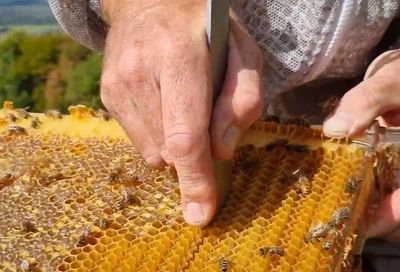With any type of honey extraction (Flow or conventional), crystallisation can be an issue. If you have crystallised honey in your Flow Frames the honey will not drain out, but there are advantages to using Flow Frames with honeys that are prone to crystallisation (e.g. rapeseed or ivy).
All honey will eventually crystallise, usually long after harvesting. However, a small variety of floral sources are prone to crystallisation inside the hive within a short timeframe after being capped. This typically includes rapeseed (canola), clover, ivy and goldenrod honey. These types of flowers produce nectar with higher levels of glucose which is what makes the honey crystallise.
Fortunately for the Flow beekeeper, Flow Frames offer numerous advantages for dealing with honey that is prone to crystallisation:
- Honey often crystallises in the super when it is removed from the hive and the temperature drops. Because the Flow Frames are harvested while still on the hive, they retain the heat from the brood box and this can reduce the likelihood of the honey crystallising in the Flow super.
- There is a short window of time between when the honey is capped and ready and when it crystallises – the Flow Hive enables quick and easy harvesting to support the beekeeper to take advantage of harvesting liquid honey within this short timeframe.
- The beekeeper is able to sample the honey without opening the super to check if the honey is ripe and ready for harvest. This is done by simply inserting the Flow key only an inch or so down the harvesting cavity and harvesting a small amount. Stu talks about this and how to manage crystallised honey in the first five minutes of this video:
Some beekeepers opt to remove the Flow Super altogether when rapeseed is in flower (e.g. April to mid-May in the UK) to avoid crystallisation in their Flow Frames. In this case, they often use conventional frames to collect the rapeseed bounty which they can feed to their bees post-winter. Post-winter feeding can be used to stimulate brood rearing for upcoming honey flows, encourage hygienic behaviour to support a tidy colony, and boost or help a struggling colony on the other side of a difficult winter. Rapeseed honey can be a nutritious alternative to sugar syrup. Ivy blooms from September to November in the UK, so some beekeepers also remove the Flow super during this period.
Watch Jamie Oliver go into detail about harvesting rapeseed honey early to prevent crystallisation in the Flow Super:
If you find yourself with crystallised honey in the Flow Frames, as per conventional hive methods you can place the frames in a warming box (kept at 40°C) where the honey will liquefy again. Alternatively, whilst the frames are still on the hive, you can disrupt the cells and cappings by opening and closing the frame with the Flow key a couple of times, which will trigger the bees to remove the crystallised honey and repair the comb. Note that the bees need a good quality water source in order to be able to do this.



